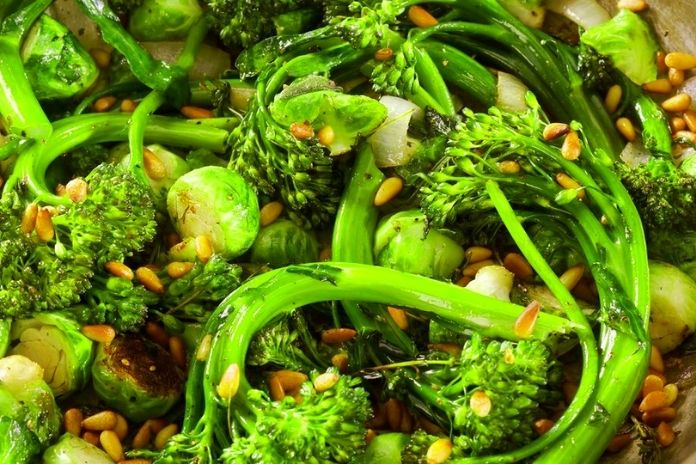When it comes to vegetable protein, most people think of legumes first. But many other types of vegetables can also come up with not inconsiderable protein content and should therefore find their way into the kitchen more often.
Fortunately, the misconception that a lot of protein can only be ingested by consuming animal products has been dispelled for some time.
Because many plants also provide a lot of protein and can, in this way, give the human organism excellent nutrition.
Ideal: Combine Vegetables And Legumes
Unbeaten and, ahead of all, the legume is an excellent source of protein rich vegetable. However , lentils, chickpeas, and beans tend to overshadow the other protein-rich vegetables.
Many types of vegetables can also be ideal suppliers of protein. Thanks to their low-calorie count, they are also particularly suitable for anyone who wants to lose weight.
Ideally, you combine plenty of vegetables with a good dose of legumes within a meal and thus achieve the full range of healthy ingredients.
Above all, the following eight types of vegetables should regularly find their way onto the menu – because they are bursting with protein.
Spinach
When it comes to the beneficial effects of vegetables, green leafy vegetables come first. And the powerhouse among them, spinach, is also no stranger to many.
Spinach is one of the most nutrient-dense green leafy vegetables you can eat.
The leaves not only provide the body with a high amount of folic acid, manganese, magnesium, iron, potassium, calcium, vitamins A and C, but they also provide a good portion of protein.
Protein accounts for a whopping 30 percent of the calories in spinach – for 100 grams, that’s a good 2.9 grams of protein. In addition, all essential amino acids are included.
But that’s not all the power plant offers: Spinach also contains plant compounds that can increase antioxidant defenses and reduce inflammation.
Plenty of good reasons to eat spinach more often.
Chinese Cabbage
Chinese cabbage and its close relative, bok choy, are good plant-based protein sources. Just 70 grams of Chinese cabbage contain one gram of protein.
Cabbage is also an excellent source of folic acid, calcium, potassium, manganese, iron, and vitamins A, C, and K.
Like spinach, Chinese cabbage is also rich in antioxidants, which are mainly found in the plant’s outer leaves.
Chinese cabbage is primarily used in many Asian recipes such as stir-fries, soups, and spring rolls. The cabbage gets a healthy bonus when it is fermented– as in kimchi production. The fermentation process creates bacteria that support a healthy intestinal flora.
Asparagus
For many Germans, nothing beats the asparagus season. Anyone who has not been able to get as much from asparagus in combination with hollandaise sauce and schnitzel should still give the vegetables a chance.
Because with 2.2 grams of protein per 100 grams, asparagus not only comes with a lot of protein – it also provides the body with all kinds of healthy micronutrients.
B vitamins, folic acid, copper, manganese, phosphorus, magnesium, and vitamins A and K.
Chopping the long vegetables into the salad or pimping other dishes with them also pleases the intestines. The fructooligos accharides it contains have a prebiotic effect and stimulate the growth of friendly bacteria to the intestines.
Broccoli
Another popular vegetable is broccoli. Although this plant is deficient in calories (100 grams come with just 25 kcal, but 2.8 grams of protein, therefore), broccoli turns out to be an absolute powerhouse.
It contains plenty of folic acids, manganese, potassium, phosphorus, vitamins K And C, and all the essential amino acids that the body needs.
Broccoli also supplies the organism with plant compounds and flavonoids such as kaempferol. These can have antioxidant and anti-inflammatory effects.
To avoid losing the health-promoting effects of the plant when cooking, it is advisable to enjoy the broccoli raw or steamed – it tastes excellent in summer, especially in salads.
Kale
Kale probably divides minds in terms of taste. Some love it; others don’t really like hearty cabbage.
Whether you’re a fan or not, there’s no denying the health benefits of dark green leafy vegetables. One hundred grams contain a substantial 2.5 grams of protein, but only 32 calories.
The green cabbage is also an excellent vitamin C, calcium, potassium, and manganese source. It also provides the body with plenty of antioxidants.
Brussels Sprouts
Brussels sprouts are also often spurned because of their taste. This typical winter vegetable can come up with all sorts of healthy ingredients.
Their vitamin C content is outstanding, bitter substances support the fat metabolism, and antioxidants protect the body cells.
At the same time, the vegetable is, of course, a natural protein bomb: 100 grams of Brussels sprouts contain around 3.5 grams of vegetable protein. You like to give the little tubers another chance, don’t you?
So: Brussels sprouts can even taste damn delicious if prepared correctly.
Cauliflower
Like broccoli, cauliflower also provides a high amount of protein for the number of calories it comes with. 100 grams of white cabbage offers the body two grams of protein but only 25 calories.
It’s also a great source of vitamins C and K and minerals like potassium, manganese, magnesium, phosphorus, calcium, and iron.
Cauliflower also contains high levels of a specific mustard oil glycoside compound called sinigrin. Studies suggest that this compound has anti-cancer, antioxidant, and anti-inflammatory properties.
However, since the content of the health-promoting substances decreases sharply after just five minutes of cooking, it is advisable to eat these vegetables raw or lightly steamed.
The Little Healthy Extra
In addition to the vegetables already mentioned, another little powerhouse deserves a place on this list: the watercress.
Protein accounts for around half of the calories in the small vegetable. 100 grams of watercress comes to 2.3 grams of protein.
However, the cress is not suitable as a prominent cooking ingredient like spinach or broccoli but should be used to refine dishes such as salads, smoothies, or sandwiches.
ALSO READ: MEAT PLUS VEGETABLES: THESE ARE THE 5 BEST-FIT MEALS

